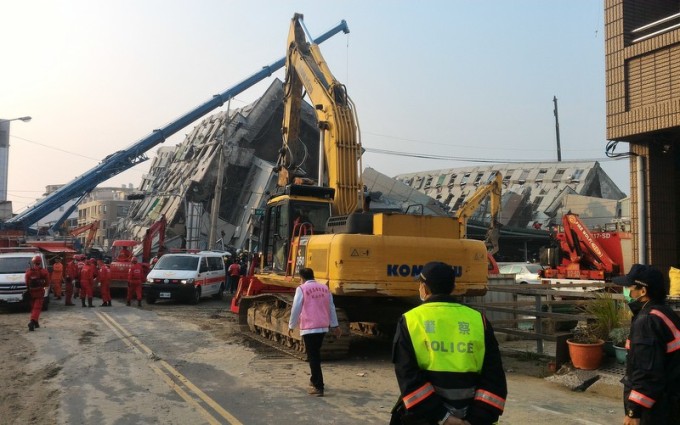At 3.57 on the morning of Saturday, February 6, a magnitude-6.4 earthquake struck southern Taiwan. My wife, son and I were shaken awake. It was a scary tremor, for sure, but almost immediately I sensed our lives weren’t in danger; the ceiling wasn’t about to crash down on our heads. The power was out (and would stay out for ten hours), so I grabbed a flashlight and started inspecting the house for cracks. I found none, but downstairs a drinking glass had rolled off the table and smashed on the floor. That was our only material loss. A few minutes later, we heard a neighbor saying their water tank had toppled over (many homes in Taiwan, including ours, have a stainless steel water tank on the roof). But within a few hours, it was clear many people had lost their homes, cars – or lives.
I couldn’t get back to sleep. Within an hour, photos of earthquake destruction began appearing on social media. We own three properties in the Tainan area, and because it was necessary to inspect them for earthquake damage, I left our house soon after dawn, walking into Xinhua so I could catch a bus. (Normally, I’d ride a motorcycle or bicycle, but the power outage meant we couldn’t open our garage.) I detoured to see the local King’s Town Bank branch; the first two floors had collapsed and what remained was listing. Fortunately, the upper floors were unoccupied at the time of the quake, so no one was trapped inside. In addition to police making sure no one got too close, there was a military police unit with rifles, just in case someone decided to excavate the bank’s vaults.
I posted a few photos on Facebook, and within 10 minutes received this message from a photographer I know. He used to work in Taipei, but is now based in Hong Kong:
I just saw your quake photos. Do you have high quality jpgs you could send us? We pay.
This turned out to be the first of three requests to provide images or video footage of the disaster. Over the next 24 hours, I also got three requests to do Skype or telephone interviews about the quake (from New York, Moscow and an online outfit that didn’t clearly identify itself).
Depending on who asked and how they phrased it, I either graciously turned down or totally ignored each and every invitation. I had enough on my plate: There were toppled bookcases to be righted, cupboard contents to be picked up, and chips of paint to be swept up. But the key reason was a simple lack of desire.
It was flattering to be asked, but only slightly. Of English-language reporters/writers based in Taiwan, no one was better located than me to cover the consequences of the earthquake. Our home is just 2.4 km from the King’s Town Bank building. My office is 3.4 km south of where Weiguan Apartment Building crashed over (pictured here; 115 people inside were killed), and just 800 m from a three-story residential building where the first floor gave way, spectacularly crushing three parked cars but hurting no one.
This wasn’t so much a refusal to “feed the beast” (I’m part of the beast, after all), but the certainty I had little to offer. I could give an interviewer a mundane account of the event, but no real insights. A broken glass and no electricity is hardly newsworthy. Days later, I came up with a semi-satisfactory simile: Experiencing a strong earthquake is like being on a rattling, shuddering train as it rushes down a hill; you realize the brakes don’t work, and you’ve no idea if you’ll survive the curve you’re hurtling towards.
The idea of standing amid traumatized relatives and neighbors, perhaps getting in the way of rescue workers, holds no appeal. The fifteen minutes I spent at the remnants of Weiguan Apartment Building were enough. The day reinforced what I’ve long known: I’m a features writer, not a news guy. I like to explore shifts and trends. I’m intrigued by what is happening, not what’s just happened. I like to think the articles I write have a longish lifespan – a few months at least, perhaps even a year or two.
I wasn’t the only person approached by overseas media, of course. Klaus Bardenhagen, a German reporter who’s been based in Taipei for six years, gave some telephone interviews, while making it clear to everyone he was no nearer than Taichung (about 150 km away) during the quake and its aftermath, and that all his knowledge came local media channels.
I agreed wholeheartedly when he later told me: “Post-disaster reporting is often some of the most unnecessary journalism imaginable. Basically, everyone knows the situation. Constant updates don’t provide greater understanding. You take up time and space which could be used to report more pertinent news. Also, victims are bothered in the process. It’s all about emotional human stories. Media organizations think their audiences want more and more of it. It’s the journalistic equivalent of fast food. Easy to munch down, unhealthy – and you feel bad afterwards.”
I’m no reporter, but I was in Kangshan, and I tweeted that I’d survived the quake to let friends know I was okay. I immediately got a few DMs, and was almost going to do an on-air interview with a big media outlet when I backed out…it all happened so quickly, but it felt wrong to say ‘no, everything is fine here in Kangshan the market is heaving with new year preparations’ when so many people were suffering…
LikeLiked by 1 person